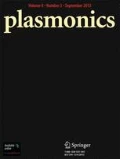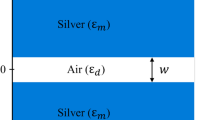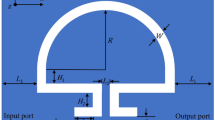Abstract
In this paper, to achieve high-quality filters, nanostructured plasmon resonators are proposed. The structure of proposed resonator is based on metal-dielectric-metal configuration and is designed in the range of 1550-nm telecommunication wavelength. To evaluate the proposed structure, finite-difference time-domain method and analytical method of coupled mode theory have been used. To obtain optimal results, the effects of the number of waveguides as well as the radius of circular and ring waveguides were investigated. The appropriate results will be obtained by considering a strong coupling between the incoming light and the surface plasmon. In addition, two transient and static wave structures have been used to evaluate the structure. The simulation results show that besides filtering behavior of the structure, it is possible to control the surface plasmon propagation speed in the proposed structure. Therefore, it is expected that the proposed structure will be used in many parts of a telecommunication link such as multiplexers.









Similar content being viewed by others
Availability of Data and Material
All data included in this paper are available upon request by contacting the corresponding author.
References
Jamalpoor K, Zarifkar A, Alighanbari A (2019) A GaAs-based plasmonic source employing a nanoscale vertical cavity. Opt Quant Electron 51(5):1–9
Jamalpoor K, Zarifkar A (2018) Utilising graphene antidots for implementation of a broadband terahertz absorber. Micro & Nano Letters 13(12):1712–1715
Jamalpoor K, Zarifkar A, Miri M (2017) Application of graphene second-order nonlinearity in THz plasmons excitation. Photonics Nanostruct Fundam Appl 26:80–84
Jamalpoor K, Zarifkar A (2017) Analytical investigation of surface plasmon excitation on a graphene sheet using four-wave mixing. Appl Opt 56(3):434–438
Liang GQ, Chong YD (2013) Optical resonator analog of a two-dimensional topological insulator. Phys Rev Lett 110(20):203904
Salzenstein P, Diallo S, Zarubin M (2018) Electrically driven thermal annealing set-up dedicated to high quality factor optical resonator fabrication. Journal of Power Technologies 98(2):198–201
Jali MH et al (2019) Optical characterization of different waist diameter on microfiber loop resonator humidity sensor. Sensors and Actuators A Phys 285:200–209
Ghadrdan M, Mansouri-Birjandi MA (2017) Low-threshold ultrafast all-optical switch implemented with metallic nanoshells in the photonic crystal ring resonator. Superlattice Microst 111:789–795
Papageorge AT, Kollár AJ, Lev BL (2016) Coupling to modes of a near-confocal optical resonator using a digital light modulator. Opt Express 24(11):11447–11457
Nurmohammadi T, Abbasian K, Yadipour R (2018) Ultra-fast all-optical plasmonic switching in near infra-red spectrum using a Kerr nonlinear ring resonator. Optics Communications 410:142–147
Srivastava YK et al (2017) MoS2 for ultrafast all-optical switching and modulation of THz Fano metaphotonic devices. Adv Opt Mater 5(23):1700762
Li C et al (2017) Multiple Fano resonances based on plasmonic resonator system with end-coupled cavities for high-performance nanosensor. IEEE Photonics J 9(6):1–9
Jankovic N, Cselyuszka N (2018) Multiple Fano-like MIM plasmonic structure based on triangular resonator for refractive index sensing. Sensors 18(1):287
Hosseinbeig A, Pirooj A, Zarrabi FB (2017) A reconfigurable subwavelength plasmonic fano nano-antenna based on split ring resonator. J Magn Magn Mater 423:203–207
Zhang X, Cui TJ (2020) Deep-subwavelength and high-Q trapped mode induced by symmetry-broken in toroidal plasmonic resonator. IEEE Trans Antennas Propag
Negahdari R, Rafiee E, Emami F (2019) Realization of all-optical plasmonic MIM split square ring resonator switch. Opt Quant Electron 51(7):235
Kewes G et al (2018) Heuristic modeling of strong coupling in plasmonic resonators. ACS Photonics 5(10):4089–4097
Khani S, Danaie M, Rezaei P (2019) Design of a single-mode plasmonic bandpass filter using a hexagonal resonator coupled to graded-stub waveguides. Plasmonics 14(1):53–62
Lin J et al (2020) Tailoring the lineshapes of coupled plasmonic systems based on a theory derived from first principles. Light Sci Appl 9(1):1–11
Chou Chao CT et al (2020) Highly sensitive and tunable plasmonic sensor based on a nanoring resonator with silver nanorods. Nanomaterials 10(7):1399
Huang ZQ, Yi SH, Chen HX, He XQ (2019) Parameter analysis of damaged region for laminates with matrix defects. J Sandw Struct Mater 425695259
Gao N et al (2021) Elastic wave modulation of double-leaf ABH beam embedded mass oscillator. Appl Acoust 173:107694
Yang Y, Chen H, Zou X, Shi X, Liu W, Feng, L.,... Chen, Z. (2020) Flexible carbon-fiber/semimetal bi nanosheet arrays as separable and recyclable plasmonic photocatalysts and photoelectrocatalysts. ACS Appl Mater Interfaces 12(22):24845–24854
Sheng H, Wang S, Zhang Y, Yu D, Cheng X, Lyu, W.,... Xiong, Z. (2021) Near-online tracking with co-occurrence constraints in blockchain-based edge computing. IEEE Internet Things J 8(4):2193–2207
Chen Z, Zhang H, He X, Fan G, Li X, He, Z.,... Zhang, L. (2021) Fabrication of cellulosic paper containing zeolitic imidazolate framework and its application in removal of anionic dye from aqueous solution. BioResources 16(2):2644–2654
Zhang M, Zhang L, Tian S, Zhang X, Guo J, Guan X, Xu P (2020) Effects of graphite particles/Fe3+ on the properties of anoxic activated sludge. Chemosphere (Oxford) 253:126638
Tong X, Ou X, Wu N, Wang H, Li J, Tang Y (2021) High oxidation potential ≈6.0 V of concentrated electrolyte toward high-performance dual-ion battery. Adv Energy Mater 2100151
Wang M, Tang Y (2018) A review on the features and progress of dual-ion batteries. Adv Energy Mater 8(19):1703320
Du X, Li J, Niu G, Yuan J, Xue K, Xia, M.,... Tang, J. (2021) Lead halide perovskite for efficient optoacoustic conversion and application toward high-resolution ultrasound imaging. Nat Commun 12(1):3348
Shi C, Zhang X, Zhang X, Chen P, Xu L (2021) Ultrasonic desulfurization of amphiphilic magnetic-Janus nanosheets in oil-water mixture system. Ultrason Sonochem 76
Cheng H, Li T, Li X, Feng J, Tang, T, Qin D (2021) Facile synthesis of Co9S8 nanocages as an electrochemical sensor for luteolin detection. J Electrochem Soc
Chen H et al (2020) Multi-population differential evolution-assisted Harris hawks optimization: Framework and case studies. Futur Gener Comput Syst 111:175–198
Wang M, Chen H (2020) Chaotic multi-swarm whale optimizer boosted support vector machine for medical diagnosis. Appl Soft Comput 88:105946
Xu Y et al (2019) Enhanced Moth-flame optimizer with mutation strategy for global optimization. Inf Sci 492:181–203
Zhao X et al (2019) Chaos enhanced grey wolf optimization wrapped ELM for diagnosis of paraquat-poisoned patients. Comput Biol Chem 78:481–490
Li C et al (2018) Developing a new intelligent system for the diagnosis of tuberculous pleural effusion. Comput Methods Programs Biomed 153:211–225
Wang M et al (2017) Toward an optimal kernel extreme learning machine using a chaotic moth-flame optimization strategy with applications in medical diagnoses. Neurocomputing 267:69–84
Xia J et al (2017) Ultrasound-based differentiation of malignant and benign thyroid nodules: an extreme learning machine approach. Comput Methods Programs Biomed 147:37–49
Shen L et al (2016) Evolving support vector machines using fruit fly optimization for medical data classification. Knowl-Based Syst 96:61–75
Chen H-L et al (2016) An efficient hybrid kernel extreme learning machine approach for early diagnosis of Parkinson′ s disease. Neurocomputing 184:131–144
Hu L et al (2015) An efficient machine learning approach for diagnosis of paraquat-poisoned patients. Comput Biol Med 59:116–124
Xu X, Chen H (2014) Adaptive computational chemotaxis based on field in bacterial foraging optimization. Soft Comput 18(4):797–807
Zhang Y et al (2020) Boosted binary Harris hawks optimizer and feature selection. Engineering with Computers 25:26
Zhang Y et al (2020) Towards augmented kernel extreme learning models for bankruptcy prediction: algorithmic behavior and comprehensive analysis. Neurocomputing. https://doi.org/10.1016/j.neucom.2020.10.038
Zhao D et al (2020) Chaotic random spare ant colony optimization for multi-threshold image segmentation of 2D Kapur entropy. Knowl-Based Syst p 106510
Tu J et al (2021) Evolutionary biogeography-based whale optimization methods with communication structure: Towards measuring the balance. Knowl-Based Syst 212:106642
Shan W et al (2020) Double adaptive weights for stabilization of moth flame optimizer: balance analysis, engineering cases, and medical diagnosis. Knowl-Based Syst p 106728
Yu C et al (2021) SGOA: Annealing-behaved grasshopper optimizer for global tasks. Eng Comput p 1–28
Hu J et al (2020) Orthogonal learning covariance matrix for defects of grey wolf optimizer: insights, balance, diversity, and feature selection. Knowl-Based Syst p 106684
Zhao X et al (2014) Feature selection based on improved ant colony optimization for online detection of foreign fiber in cotton. Appl Soft Comput 24:585–596
Yu H et al (2020) Dynamic Gaussian bare-bones fruit fly optimizers with abandonment mechanism: method and analysis. Eng Comput p 1–29
Acknowledgements
The authors would like to thank the reviewers for their thoughtful comments.
Author information
Authors and Affiliations
Contributions
All authors contributed equally.
Corresponding author
Ethics declarations
Ethics Approval
Not applicable.
Consent to Participate
Not applicable.
Consent for Publication
Not applicable.
Conflict of Interest
The authors declare no competing interests.
Additional information
Publisher's Note
Springer Nature remains neutral with regard to jurisdictional claims in published maps and institutional affiliations.
Rights and permissions
About this article
Cite this article
Afroozeh, A. Numerical and Analytical Modeling of Plasmonic Filter with High Q-Factor Based on “Nanostructured Resonator”. Plasmonics 17, 371–379 (2022). https://doi.org/10.1007/s11468-021-01527-1
Received:
Accepted:
Published:
Issue Date:
DOI: https://doi.org/10.1007/s11468-021-01527-1




